Concern for preserving newspapers in 1849…
September 11, 2012 by TimHughes · 1 Comment
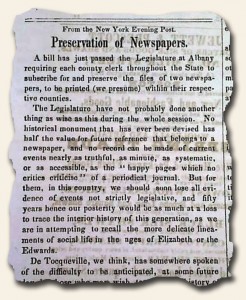 Over 160 years ago the New York legislature had the foresight to be concerned about the future holdings of newspapers, and more importantly the loss of the unique perspective of history which can only be obtained through newspapers of the day. Their cause remains as relevant today as it was in 1849.
Over 160 years ago the New York legislature had the foresight to be concerned about the future holdings of newspapers, and more importantly the loss of the unique perspective of history which can only be obtained through newspapers of the day. Their cause remains as relevant today as it was in 1849.
The photos show the entire editorial as found in the “Vermont Chronicle” of Windsor, May 2, 1849, but portions include: “…No historical monument that has ever been devised has half the value for future reference that belongs to a newspaper, & no record can be made of current events nearly as truthful, as minute, as systematic, or as accessible, as the ‘happy pages which no critics criticise’ of a periodical journal…” and “…De Tocqueville…has somewhere spoken of the difficulty to be anticipated at some future day of those who may wish to trace the history of our people for the want of durable monuments or records of their current life & achievements…that the newspaper was almost our only historical repository & that was usually destroyed as soon as its contents were glanced at…” and much more.
A fascinating article on the need to preserve newspapers; something which all of us in this hobby continue to do in some small way.
The entire text of this intriguing article may be viewed at: “Vermont Chronicle” of Windsor, May 2, 1849
Value of a city wife…
June 15, 2012 by TimHughes · Leave a Comment
This article in the “Detroit Free Press” issue of November 8, 1946 needs no further explanation.
Atmosphere versus Events – which newspaper-collecting path to tread?
May 28, 2012 by GuyHeilenman · Leave a Comment
 The following is a guest post by blogger Chee Seng:
The following is a guest post by blogger Chee Seng:
Newspaper-collecting is something of an oddity in the collectibles and antiques scene. That’s because it’s not the printing house – or the paper/ink – which makes a newspaper valuable to the collector. It is something more ephemeral. It’s the very words that are printed on those yellowing sheets (or not so yellowing for pre-1875 issues), and how they connect to the unfolding story of the times. In other words, it is content, not the vessel, that can elevate one newspaper above all others, in the eye of the collector.
It’s also true to say that, because that collection of news-stories, articles, pictures and adverts are a snapshot of the very essence of an historical epoch – its life-and-times, its mores and outlook – that collectors can be looking at the same newspaper with very different eyes. Some want plenty of local interest, some are fixated on a great news story, some collect certain types of coverage religiously – and some are even looking for specific writers or illustrators.
But while no two-collectors are alike, you can split approaches to newspaper-collecting into two great camps. Those who are chasing after ‘events’, and those who want to steep themselves in the ‘atmosphere’. If you want to understand the sorts of newspapers you should be collecting,
you’d do well to try and understand the different viewpoints of these two camps. It’s not just a philosophical point – chasing ‘atmosphere’ versus ‘event’ can help decide whether a paper is worth one dollar, or a hundred.
It’s fair to say that ‘event’ collectors are hanging their collecting coats, first-and-foremost, from those real big hooks in the historical calendar. Those unforgettable and universal events that are remembered long after they have happened – and often very far from their point of origin. Good examples of these mega-events include the assassination of John F Kennedy or Abraham Lincoln,
the landing on the Moon, or the sinking of the Lusitania.
The reason these big events are so important is that, for many people, who would otherwise not come close to buying a historic newspaper, they resonate a strong chord with them. Having such a bold historical headline, framed and on the wall, is a way of displaying this strong emotional connection. And because so many people are seeking out these original ‘event’ newspapers, the pent-up demand drives up the value.
And of course, much of the interest in collecting newspapers, then, inevitably follows this money. Indeed, many people are drawn into the hobby purely to see if if they can reap big rewards from the ‘events’ held in that stack of newspapers, found stored in the attic. There is nothing wrong with taking such a monetary-influenced path – after all, it sustains many collectible hobbies. But it would
be sad if your newspaper-collecting was restricted to only these mammoth events – which can be counted on fingers and toes for most countries.
This is where the second path of newspaper collecting may be found to be ‘enriching’, on a different level: collecting for ‘atmosphere’. The starting point for the atmosphere collector is usually a personal interest in a particular era. Some people are drawn to the life-or-death drama of the World Wars – where even local news-stories are set against a backdrop of that wider struggle. Others are
find the moral contrasts of Prohibition-era America, for example, with its gangsters and raids and flighty fashions, irresistible.
Following this atmospheric path gives you a lot more scope to learn a little from history’s lessons. However, this is not the history taught in the dry words of the history text books – but in the often vivid and colorful language of the local news-hack. You may also find nuggets of historical interest that other collectors may also find fascinating – and so another route to a higher-than-normal
valuation can open up.
For example, there was a particular buzz, recently, over ‘frontier rags’ – newspapers that rolled out across the frontier, as the West was opened up. Some of these papers had short printing runs, and even shorter lives, as towns boomed and bust. That makes them pretty rare and exotic, and so a lively market grew up around these.
Of course its impossible to predict trends in atmospheric collecting such as these. Far better is to follow your instincts, and build a collection around what interests you. That way a labor of love will provide its own rewards, and any financial boon will come as a pleasant surprise. And that motto makes sense whichever path – event or atmosphere – your choice to take.
Newspaper publisher shows his bias…
October 1, 2011 by TimHughes · 1 Comment
This curious item appeared in “The Weekly Crescent City” newspaper from New Orleans, August 15, 1841. He goes to some length to show the value in paying for a subscription…
Entry point to the Rare Newspapers Collectible… 18th Century…
February 3, 2011 by GuyHeilenman · Leave a Comment
Over the past month the History’s Newsstand Blog has explored the lower-end entry points into the hobby of collecting rare and early newspapers. This next installment takes us back to the 18th century. The further we move back in time the higher (price-wise) is the entry point. One of the common ways to keep your early (into the hobby) 18th century collecting budget under control is to start by collecting newspapers/magazines from England. Typically, reports on American affairs found within British publications cost as little as 1/10 (and sometimes even less percentage-wise) than the corresponding reports in American issues. With this in mind…
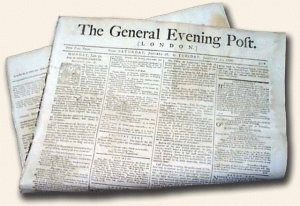 The following selection provides a glimpse of the wide variety of 18th century issues available valued at $25* and under. Many more exist on the Rare Newspapers’ website, but others can be found throughout the collectible community as well. The item numbers for each are linked to corresponding images.
The following selection provides a glimpse of the wide variety of 18th century issues available valued at $25* and under. Many more exist on the Rare Newspapers’ website, but others can be found throughout the collectible community as well. The item numbers for each are linked to corresponding images.
The oldest newspaper in the world…
120436 THE LONDON GAZETTE, England, dates ranging from 1726 to 1730 – This is the oldest continually published newspaper in the world, having begun in 1665 and is still being published today. Reporting is almost entirely concerned with Parliamentary items and European news with some advertisements near the back of the issue. $18.00*
From Pre-Revolutionary War England…
121059 THE ST. JAMES CHRONICLE; OR, THE BRITISH EVENING POST, London, England, 1767. Nice engraving in the masthead makes this a displayable issue. Various news of the day and a wealth of ads, from not long before the outbreak of the Revolutionary War. $18.00*
From Post-Revolutionary War England…
208968 THE GENERAL EVENING POST, London, 1792 A nice “typical” folio-size newspaper of 4 pages from the 18th century. There is a wealth of news of the day on the front page and inside pages with some ads scattered throughout as well. $18.00*
By the town critic…
121100 THE CONNOISSEUR, London, 1755. See the photo below for an example of this title from our archives. An uncommon and early title “By Mr. Town, Critic & Censor General” as noted in the masthead. Done in editorial format. $20.00*
From 18th century Scotland…
208447 THE EDINBURGH EVENING COURANT, Scotland, 1785. A nice 18th century Scottish newspaper with the entire front page taken up with ads, with various news of the day on the inside pages. Some of the ads have illustrations as well. Complete in 4 pages, partial red-inked tax stamp on the front page, folio size, some light browning or dirtiness, but in generally nice condition. $20.00*
Additional issues priced at $25* and under may be viewed at: Entry Level Newspapers
* All prices shown were valid as of the release date of this post.
View the following to explore the History’s Newsstand Blog’s featured posts on the upper end of the collectible: “Prices Realized” and “Most Collectible Issues“.
Entry point to the Rare Newspapers Collectible… 19th Century…
January 20, 2011 by GuyHeilenman · Leave a Comment
In the past the History’s Newsstand Blog has featured posts on the upper end of the collectible: “Prices Realized” and “Most Collectible Issues“. We are now taking a look at the other end of the spectrum – (low cost) entry points into the hobby. A few weeks ago we explored low cost issues from the 20th century. This post moves back in time to the 19th century.
The following selection provides a glimpse of the wide variety of 19th century issues available valued at $15* and under. Areas of interest include the War of 1812, religious-themed, youth-themed, snap-shots of 19th century city life, and more. Many more exist on the Rare Newspapers’ website, but others can be found throughout the collectible community as well. The item numbers for each are linked to corresponding images.
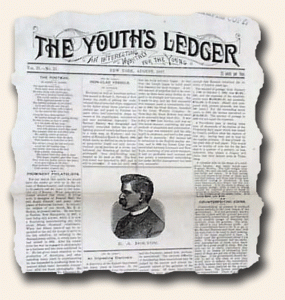 Introductory Issue from the 1800’s…
Introductory Issue from the 1800’s…
209016 An original issue from the 1800’s to help jump start your collection. This issue is guaranteed to be original, complete, and to be dated in the 1800’s. We do not offer reproductions of any kind! There is a limit of 10 issues per customer at this price. See the images for examples of the condition and look of the issue you will receive. The image shows several issues to give you a sense of the various titles/conditions you may receive, but please know this listing is for a single issue – at a great price. $3.00*
The War of 1812…
207496 COLUMBIAN CENTINEL, Boston, dated during the War of 1812. The issue you will receive is similar to the issues shown in the image – slight wear, minor staining and foxing, etc.. The issue will be dated from during the War of 1812, and will have war related news and news of the day. A great issue to own at an incredible price. $7.00*
From France…
153338 GALIGNANI’S MESSENGER, Paris, 1837. An interesting newspaper from France but printed in English, and featuring a black-inked tax stamp on an inside page. Various news of advertisements. Four pages, nice condition. Note: The policy/purpose of this title was to promote good feeling between England and France, and was highly regarded. $13.00*
19th century publication for youth…
152963 THE YOUTH’S LEDGER, New York, NY, 1887. “An interesting monthly for the Young” as is printed in the masthead. See the photo for an example of the “look” of this title from our archives. This is a nice issue to have from this location and period in history. Six pages approximately 16″x11″. $11.00*
Pittsburgh, PA… just before steel production…
153013 THE PITTSBURGH LEADER, Pittsburgh, PA, 1873. State, local and national news from this era. Interesting to have news of the day from just before steel production hit in full force. See the photo for an example of this title from our archives. Note that the photo is “generic” and the issue you get will not have these specific photos or be of this specific date but will have the format as shown. 21″x17″. Four pages and in nice condition. $15.00*
Exploring the influence of war on domestic Life…
153036 ADVOCATE OF PEACE, (Hartford, Connecticut), 1834. An interesting magazine which has war as its theme, and the value of peace as opposed to war. Note that the photo is “generic” and the issue you get will not have this specific date but will have the format as shown. Forty-six pages, measuring 9″x6″, disbound without outer wrappers. $11.00*
Additional issues priced at $15* and under may be viewed at: Entry Level Newspapers
* All prices shown were valid as of the release date of this post.
Entry point into the Rare Newspapers Collectible… 20th Century…
January 6, 2011 by GuyHeilenman · 2 Comments
In the past the History’s Newsstand Blog has featured posts on the upper end of the collectible: “Prices Realized” and “Most Collectible Issues“. To kick off the new year we thought it might be nice to look at the other end of the spectrum: “Entry Points to the Rare Newspapers Collectible”. Throughout this month we will target examples of the least expensive collectible newspapers available for each century.
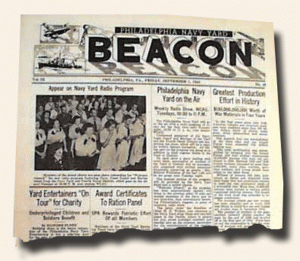 Our journey begins with the 20th century…
Our journey begins with the 20th century…
The following selection provides a glimpse of the wide variety of issues available valued at $15* and under. Areas of interest include shipping, finance, theater, historic events, and more. Many more exist on the Rare Newspapers website, but others can be found throughout the collectible community as well. The item numbers for each are linked to corresponding images.
A World War II newspaper from the Navy Yard…
575571 BEACON, Philadelphia Navy Yard, 1944 A military paper produced at the Navy Yard with a great wealth of war-related content and a war-related masthead as well.
Eight pages, 10 1/2 by 16 pages, printed on high quality paper, nice condition. $9.00*
From the Panama Canal Zone…
579280 THE PANAMA CANAL RECORD, Balboa Heights, Canal Zone, 1928. A little magazine subtitled: “Official Publication of the Panama Canal” with a wealth of data concerning the canal and its use. Approximately twenty-six pages measuring 9″x6″. $12.00*
World War 1…
161488 OFFICIAL BULLETIN, Washington, DC, 1918. An unusual newspaper published daily by the “Committee on Public Information”, meant to keep the public informed of both political & military matters, particularly during the WWI period. Note that the photo is “generic” and the issue you get will be of a slightly different date but will have the format as shown. Sixteen pages measuring 12″x9″. Lightly browned with some minor edge tears. $10.00*
For the little child in all of us…
161498 THE YOUTH’S COMPANION, Boston, Massachusetts, 1900. A charming newspaper with several short stories for children, featuring several wonderful illustrations, an ornate masthead, and plenty of advertisements. $10.00*
In-house real estate periodical…
161495 STROUT’S BUGGY-SEAT CONFIDENCES, Boston, Massachusetts, 1911. A curious little publication by and for those working for the Strout real estate company, the “World’s Largest Farm Agency”. Printed on coated stock. $10.00*
Movie News! Burt Lancaster & Ava Gardner…
564394 MOTION PICTURE DAILY, from New York, dated September 28, 1956. Interesting little publication for and about the movie industry, giving the latest information on the various background events of the motion picture world. Television news as well. Too much to mention. 6 pages measuring 12″x9″, printed on coated stock paper. Nice shape. $10.00*
Additional issues priced at $15* and under may be viewed at: Entry Level Newspapers
* All prices shown were valid as of the release date of this post.
Collecting Historic and Rare Newspapers Basics – Part Two
August 9, 2010 by GuyHeilenman · 1 Comment
The following guide is posted on History’s Newsstand’s eBay Store. It is the second part of a primer on collecting Rare & Early Newspapers:
 The purpose of this 2nd guide concerning historic, original, collectible and/or rare newspapers is to answer additional questions related to the hobby:
The purpose of this 2nd guide concerning historic, original, collectible and/or rare newspapers is to answer additional questions related to the hobby:
- Why are they so inexpensive?
- What might I find within the pages of a Rare Newspaper?
- What is the background of the (apparent) use of “f” vs. “s”?
- What is meant by “2nd-rate”?
- What is the value of my newspaper?
- How was 17th & 18th Century paper made?
- Are early issues with irregular type-set authentic?
1. Why so inexpensive?
You can find newspapers published during George Washington’s administration for $35, issues with front page accounts of Indian skirmishes for $25, and genuine issues published in 1685 for as little as $30. A hobby still very much undiscovered by the public, prices for genuine, complete newspapers dating as far back as the 1600’s are very low due to limited demand (at this time). For more than 30 years, we have dealt exclusively in the niche market of early newspapers, buying in huge quantities at very low prices to amass an inventory of over 2 million issues which are now available for the historical hobbyist. There is no better time to begin amassing ah historical newspaper collection – while still on the up-side of the hobby’s appeal.
2. What might I find within the pages of a Rare Newspaper?
Read the Boston Gazette of March 12, 1770 and learn of the massacre in that city and gain an appreciation of the revolutionary spirit never before imagined. Read 1st hand reports on the Civil War. View ads and reports from the American Wold West. View the Banner Headlines of some of the biggest events from the 20th Century. Historic newspapers are a firsthand reflection of life at a time when descriptive ads for runaway slaves were commonplace; when Paul Revere advertised his bell foundry in local papers; when recently enacted laws, signed in type by George Washington, were published in the daily paper. There is no better way to obtain an intimate view of life during nearly any chosen period from 1666 through the late 1900’s.
Since all are original issues (not reproductions), slight imperfections such as light foxing or staining, small margin tears, an occasional front page original owner (often library) stamp, and slight fold or edge wear are common. Most issues were once bound into volumes at the end of a year for preservation and bear minor left margin irregularities due to the disbinding process. None of these potential typical imperfections cause content loss. Many newspapers dated from the 1880’s through the 1920’s are pulpish (fragile) due to commonly used print materials used during this period, and appropriate care must be given to these issues. Some issues (especially magazines) were originally published with covers or wrappers, but unless described otherwise, they have long since been removed.
3. What is the historical background of the use of “f” vs. “s”?
Centuries ago before the printing press there were grammatical reasons for use of a serpentine-styled “s” to be used rather than the more typical “s”. Its look was much as if an “s” was elongated and leaned to the right. When this letter was converted to a block letter for the printing press (around 1500) it looked much like an “f” but with the slash through one side & not the other–look carefully and note the difference. This letter caused confusion with the “f” ever since, and around 1750 publishers were abandoning this letter in favor of the more typical “s”, and by 1800 it was almost universally abandoned.
4. What is meant by “second rate”?
A “second rate” issue is somewhat worn, possibly with edge tears, some light staining, rubbing, or other minor disfigurements. All pages are present with no cut-outs, but the prints contained within the issue, if prints are present, would not be suitable for framing. An acceptable issue for researching content only, or if condition is inconsequential. Please do not request for us to confirm that an issue offered at the 2nd rate price contains prints that are in good condition. A 2nd rate issue is 2nd rate throughout.
5. What is the value of my newspaper?
As one might suspect there are many factors which determine value. Much like a jeweler cannot give a value of a diamond via email or a phone call, ethics would not permit anyone to place values on newspapers without seeing the issues in hand to determine authenticity condition, news placement, etc. Although viewing issues of similar date, condition, and displayablity on eBay and/or on reputable websites may give a general sense of their potential value, your best bet is to contact a reputable dealer in historic and/or rare newspapers.
6. How was 17th & 18th Century paper made?
The handmade paper used in the 17th and 18th centuries can be distinguished from paper that was made later by holding the paper up to a light and looking for “chain-lines” which are left from the wires in the paper mold. With this method, fewer fibers accumulate directly on the wire, so the paper is slightly thinner and more transparent to light. This pattern is usually very apparent and appears as lines that run about an inch apart, with several horizontal short lines connecting the long wire lines. Some modern paper has artificially-applied chain lines, and is usually referred to as “laid” paper, which is the name given to handmade chain-line paper. The handmade chain-line paper was made of cotton and/or linen rags, which were soaked in liquid until the fibers broke down into bits. Paper was formed by hand by dipping a paper mold into the fiber suspension, and then lifting and shaking off the excess water. The paper sheet was then partially dried before being removed from the mold. Modern handmade paper (used in fine printing of small editions by private presses, as well as in artists books) is basically made by the same process.
Wood pulp paper (made with a sulfite process that causes high acid residue in the paper) wasn’t widely used in the U.S. until after the American Civil War. Breakthrough in paper-making occurred when “wove” paper was invented. Wove paper was first used in a book printed in America in 1795 in a book by Charlotte Smith entitled “Elegiac Sonnets and Other Poems”. Wove paper, which shows no chain-lines, is made on a wire mold often made of brass and/or bronze wires that have been woven like fabric. Therefore, there is no chain-like pattern, and the paper has a much smoother appearance. After 1800, wove paper became the standard paper for books and other uses, although there was still some laid or chain-link paper in use through the 1820s and beyond.
The first machine-made paper in America was made in 1817 in Brandywine, Delaware, and the first newspaper printed on this paper was “Poulson’s Daily Advertiser. The major start in manufacturing paper by machine began when a French paper machine called the Fourdrinier was introduced in New York in 1827, followed by the manufacture of more of the machines two years later in Connecticut. Machine-made paper is more uniform in thickness, lacks the uneven edges of handmade paper and is weaker and more prone to tearing. Machine-made paper is made on a continuous wire mold which usually has watermarks. Although it can be hard to tell machine-made wove paper from handmade wove paper, handmade paper is usually thicker and also varies in thickness from piece to piece.
The last major development in paper manufacture was the development of wood pulp paper, which was much less expensive to manufacture than rag paper. The first successfully-made wood pulp paper was manufactured in Buffalo, New York, in 1855. By 1860, a large percentage of the total paper produced in the U.S. was still rag paper. Most of the newspapers printed in the U.S. during the Civil War period survived because they were essentially acid-free 100% rag paper, but the newspapers printed in the late 1880s turn brown because of the high acid content of the wood pulp paper. In 1882, the sulfite wood pulp process that is still in use today was developed on a commercial scale and most of the high acid content paper was used thereafter in newspapers, magazines and books.
7. Are eary issues (pre-1800) with irregular type-set authentic?
Pre-1800 Printing – A Little Background: Type was handset in the 18th century and all margins were (typically) of equal size from top to bottom. As part of the inherent crudeness of making paper back then, individual sheets might have slightly different shapes but in general all sheets were rectangular, wider than tall with pages 1 & 4 of a newspaper printed on one side and pages 2 & 3 printed on the other, then folded in half to produce the typical 4 page newspaper. It was rather common for even a regularly shaped sheet to be put on the printing press slightly askew, causing the printed sheet to appear somewhat crooked, keeping in mind everything was done by hand, and often by young hired hands. We have seen a few instances where an irregularly shaped sheet caused the print to run off one of the edges. Also, newspapers and magazines were often bound into volumes at the end of the year with the three exposed edges trimmed to look neat, and in the trimming process some text can be trimmed off if the newspaper was bound into the volume askew, or if the trimmer simply took off too much blank margin to even up the edges.
(Note) Invitation: In order to provide an ongoing resource for newcomers to the hobby, feel free to add additional insight which you feel might be beneficial to those entering the hobby on the ground floor. Our hope will be to include many of these comments within a future post. Thanks in advance for your contributions.
First newspapers in Missouri…
July 19, 2010 by TimHughes · 3 Comments
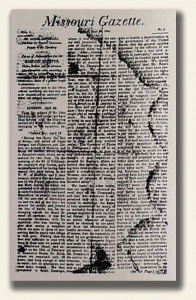 It was in 1808 when the first printing press arrived in what is now the state of Missouri, which was the Territory of Louisiana at the time. That was in St. Louis, which had about 1000 inhabitants at the time. Previous to moving to St. Louis, Joseph Charless, the printer, worked on a newspaper in Lexington, Kentucky in 1803, and then 4 years later was involved in the “Gazette” of Louisville. And it was on July 12, 1808 when Charless printed the first edition of the “Missouri Gazette“, the first newspaper in Missouri. He had 170 subscribers at the time, many of whom paid in flour, corn, beef or pork to the value of the $3 annual subscription. He changed the title to the “Louisiana Gazette” in 1809, but then when Congress created the Missouri Territory in 1812, the paper again became the “Missouri Gazette“.
It was in 1808 when the first printing press arrived in what is now the state of Missouri, which was the Territory of Louisiana at the time. That was in St. Louis, which had about 1000 inhabitants at the time. Previous to moving to St. Louis, Joseph Charless, the printer, worked on a newspaper in Lexington, Kentucky in 1803, and then 4 years later was involved in the “Gazette” of Louisville. And it was on July 12, 1808 when Charless printed the first edition of the “Missouri Gazette“, the first newspaper in Missouri. He had 170 subscribers at the time, many of whom paid in flour, corn, beef or pork to the value of the $3 annual subscription. He changed the title to the “Louisiana Gazette” in 1809, but then when Congress created the Missouri Territory in 1812, the paper again became the “Missouri Gazette“.
Not uncommon to early printers, Charless had made many enemies through his newspaper, prompting opponents to head a movement to bring another printer into town. It was in 1815 when Joshua Norvell arrived in town, and in May of that year printed his first issue of the “Western Journal“. He sold it within two years, when the new printer changed the name on May 17, 1817 to the “Western Emigrant“. It again changed hands & title again in another two years, to the “St. Louis Enquirer“.
Value for an “Ulster County Gazette”…
July 12, 2010 by TimHughes · 28 Comments
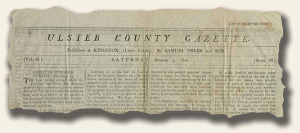 If there is any one newspaper about which we receive the most calls as to value, it would have to be the “Ulster County Gazette” issue of January 4, 1800. This Kingston, New York, newspaper documents the death of George Washington, hence the appeal.
If there is any one newspaper about which we receive the most calls as to value, it would have to be the “Ulster County Gazette” issue of January 4, 1800. This Kingston, New York, newspaper documents the death of George Washington, hence the appeal.
Anyone who has been collecting newspapers for more than a few years has likely encountered at least one of the more than 60 varieties of reprints which have been documented and which exist by the hundreds of thousands. The Library of Congress has an informative sheet which will allow one to distinguish a reprint edition from the original.
As of this date, only two genuine issues have been discovered, now in the hands of the American Antiquarian Society and the Library of Congress. Although the history of the reprints, going back to 1825, is an interesting subject in itself, my thoughts with this blog post are on the value of a genuine issue should a third one surface.
Keeping in mind that historical significance is perhaps the single most important determinant for value, The report of Washington’s death does not rank–in my opinion–on the “top shelf”. The “Ulster County Gazette” issue is a relatively late report with a Jan. 4, 1800 date (he died Dec. 14, 1799), and there is no particular significance to the city in regard to Washington; he wasn’t born there, didn’t die there, perhaps never even visited there (although during the Revolutionary War he was in that vicinity). The Declaration of Independence & Constitution rank high on the “top shelf”, and these documents in Philadelphia newspapers would be premier issues for such reports commanding values well above $100,000 each. As such, the “Ulster County Gazette” issue is famous for being a reprint and not much more.
So, the question is, should a third genuine issue surface, how much should it be worth? Yes, it is a rare newspaper as only two are known to exist, but I’m sure there are other small town newspapers from the era which are equally as rare. In our catalog 177 we will be offering a Providence, R.I. issue of January 1 for less than $2000, it being a first report also with front page mention and much inside page text regarding Washington’s death. But six institutions have this issue with perhaps a few more in private hands. I think some collectors believe the U.C.G. would be worth $100,000 or more, but I would disagree. Yes, it is “famous” as a reprint, and finding a 3rd issue would be neat, but how does this affect value? It’s a late report of Washington’s death in a small town, upstate New York newspaper which has no significance to the life of Washington. Perhaps add some premium for the notoriety of the issue, but I’m not sure I’d want to pay more than $3000 or $4000 for the issue. Step beyond the small circle of serious newspaper collectors and attempts to legitimize a hefty value would fall on deaf ears. Better reports, closer to Virginia, with earlier dates can be purchased for less.
So what are your thoughts? Feel free to share.


